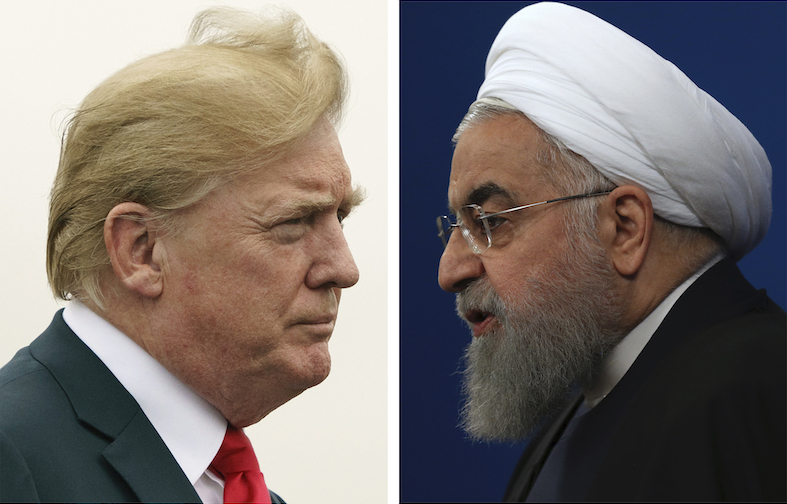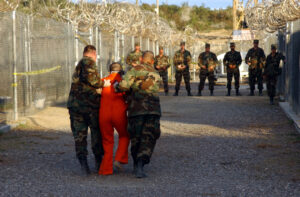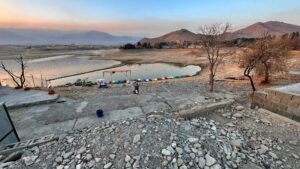There’s One Way to Stop Trump From Acting on Nuclear Threats
A trusting Senate and policy changes leave the door open for the president to launch such a unilateral attack on Iran. Congress must act. U.S. President Donald Trump and Iranian President Hassan Rouhani. (AP)
U.S. President Donald Trump and Iranian President Hassan Rouhani. (AP)
On July 22, during a meeting at the White House with Pakistan Prime Minister Imran Khan, President Trump alluded to military plans in which the U.S. could “win the war” in Afghanistan in a matter of days. “I could win that war in a week, I just don’t want to kill 10 million people,” Trump said. “Afghanistan would be wiped off the face of the earth.”
Trump did not explicitly say what weapons would be used to achieve this outcome. However, his comments implicitly invoked the use of nuclear weapons, the only military resource in the U.S. arsenal capable of killing that many people in such a short time. While it is highly unlikely President Trump reviewed any such plans regarding Afghanistan (he has been known to lie on occasion), the fact that he chose to mention a scenario that invoked a massive U.S. nuclear strike sent a signal to Afghanistan’s neighbor, Iran, that when it comes to resolving the ongoing crisis over Iran’s nuclear program, all options were, indeed, on the table.
Americans have become accustomed to presidents capable of rationally managing the awesome power of the U.S. nuclear arsenal, dating back to President Kennedy during the Cuban Missile Crisis. For two weeks in October 1962, the world was on the verge of global nuclear annihilation. President Kennedy was under pressure from the Pentagon to use military force to prevent the Soviet Union from installing nuclear-armed medium- and intermediate-range ballistic missiles on the island that would threaten much of the southern and eastern United States. Nuclear war was ultimately averted; Kennedy disregarded the advice of the military chiefs, opting instead to rely upon diplomacy.
One of the factors that weighed on Kennedy was the consequences of a nuclear conflict. In July 1961, Kennedy had been briefed for the first time on the U.S. nuclear war plan. After hearing an estimated 48 to 71 million people in the U.S. would be “killed outright,” with another 67 million in Russia and 76 million in China likewise perishing, Kennedy said to Secretary of State Dean Rusk, “And we call ourselves the human race.” That moral rejection of nuclear mass murder became the standard that had guided successive presidents when it came to nuclear conflict.
Until Donald Trump.
Trump’s casual reference to murdering 10 million Afghans wasn’t the first time he had threatened to use nuclear weapons in a precipitous fashion. In August 2017, while responding to statements made by North Korean leader Kim Jong Un, Trump declared that “North Korea best not make any more threats to the United States. They will be met with fire, fury and frankly power the likes of which this world has never seen before.”
On Nov. 14, 2017, the U.S. Senate Foreign Relations Committee did something it hadn’t done in 41 years—addressed the authority to use nuclear weapons. In convening that hearing, the Republican chairman, Sen. Bob Corker, observed, “Making the decision to go to war of any sort is a heavy responsibility for our nation’s elected leaders, and the decision to use nuclear weapons is the most consequential of all.” His Democratic counterpart, Sen. Ben Cardin, added in his opening remarks, “Given today’s challenges, we need to revisit this question on whether a single individual should have the sole and unchecked authority to launch a nuclear attack under all circumstances, including the right to use it as a first strike.”
But the event that prompted the U.S. Senate to convene such a rare hearing wasn’t casual curiosity about U.S. nuclear launch authority, but rather the words of President Trump regarding North Korea. Cardin noted in his opening remarks that, in reference to Trump’s statement, “many interpret that to mean that the president is actively considering the use of nuclear weapons in order to deal with the threat of North Korea. That is frightening.”
Robert Kehler, the former commander of the U.S. Strategic Command and a retired Air Force general, told the committee, “The decision to employ nuclear weapons is a political decision requiring an explicit order from the president.” However, Kehler said, “the law of war governs the use of U.S. nuclear weapons. Nuclear options and orders are no different in this regard than any other weapon,” adding that “the legal principles of military necessity, distinction and proportionality also apply to nuclear plans, operations and decisions.”
Under questioning from Cardin, Kehler was given a scenario in which the president, after consulting with his advisers, is told that “under the guidelines on proportionality and necessity, that this is not appropriate for use of a nuclear first-strike. Is there action that can be taken by those advisers if the president overrules that decision and says, no, we are going with a nuclear attack?”
Kehler responded that such a scenario presented a “very interesting constitutional situation” because, as a military officer, he would “be obligated to follow legal orders but not obligated to follow illegal orders.”
If there is an illegal order presented to the military, the military is obligated to refuse to follow it. Now the question is just the one that you described. It is the process leading to that determination and how you arrive at that. I would concede to you that that would be a very difficult process and a very difficult conversation. But in the scenario that you are painting here, I would also argue that there is time for that kind of a deliberate conversation on these matters.
Gen. John Hyten, the current commander of Strategic Command and Trump’s nominee for vice chairman of the Joint Chiefs of Staff, expanded on Kehler’s points a day after that 2017 Senate hearing. In comments made at the Halifax International Security Forum, Hyten said: “I provide advice to the president, he will tell me what to do. And if it’s illegal, guess what’s going to happen? I’m going to say, ‘Mr. President, that’s illegal.’ And guess what he’s going to do? He’s going to say, ‘What would be legal?’ And we’ll come up with options, with a mix of capabilities to respond to whatever the situation is, and that’s the way it works. It’s not that complicated.”
Except that it is, in fact, very complicated.
The critical issue that would have to be addressed by U.S. military commanders regarding the use of nuclear weapons under international law is that of proportionality. According to the International Court of Justice (ICJ), the issue of proportionality holds that even if an attack is directed at military targets, it would be considered unlawful if it causes harm to civilians and civilian objects that “would be excessive in relation to the concrete and direct military advantage anticipated.” It was the opinion of the ICJ that “It cannot be accepted that the use of nuclear weapons on a scale which would—or could—result in the deaths of many millions in indiscriminate inferno and by far-reaching fallout, have profoundly pernicious effects in space and time, and render uninhabitable much or all of the earth, could be lawful.” However, some within the ICJ held that the use of nuclear weapons would, in fact, be lawful if the military target was “so situated that substantial civilian casualties would not ensue.”
While there is no debating that any indiscriminate use of nuclear weapons against Iranian civilian and industrial targets would constitute a clear violation of customary international law, there are certain target sets in Iran which, because of their remoteness and composition, could fall into the category of an exception referred to in the dissenting ICJ opinion.
Iran has concentrated its uranium enrichment potential in two locations. The first is the Natanz uranium enrichment facility, which is about 19 miles from the city of Natanz (population 12,000) and 43 miles from the city of Kashan (population 400,000). The actual halls in which the cascades used to enrich uranium are installed are situated about 10 yards (nine meters) underground and are covered by thick reinforced concrete slabs further covered by 24 yards (22 meters) of earth. The second is the Fordow uranium enrichment facility, which is about 98 yards (90 meters) underground, buried into the side of a mountain. The nearest village is Fordow, with a population of about 800; the closest major population center is the city of Qom, about 20 miles away.
The U.S. currently has one nuclear weapon that is optimized for both targets—the B61-11 gravity bomb. Designed during the Gulf War to address the problem of buried Iraqi targets, the B61-11 entered the U.S. nuclear arsenal in the late 1990s. It uses a modified version of the casing employed by the GBU-28 conventional deep penetration bomb, and reportedly has a variable yield, which can be “dialed in” by the pilots depending on the target being struck, of from 0.3 to 340 kilotons. Based upon achieving a penetration depth of three meters and a yield of 0.3 kilotons, the B61-11 could destroy a target buried under more than 16 yards (15 meters) of hard rock or concrete. Similarly, a yield of 340 kilotons at the same penetration would allow a hardened target buried up to about 76 yards (70 meters) to be destroyed.
As such, if the president, acting in his capacity as the commander in chief of the Armed Forces of the United States, ordered a nuclear attack using B61-11 gravity bombs against either Natanz, Fordow or both, the issue of proportionality would be satisfied given the fact that both targets are sufficiently removed from major population centers as to limit the collateral damage that would occur following a nuclear detonation. Moreover, the hardened status of both targets means their respective destruction could not be guaranteed by conventional attacks alone.
This is the scenario that could be followed by President Trump in ordering a nuclear strike against Iran that would be considered legal under the law of war, and as such executable by his military commanders. In any event, the president could always argue that, regardless of its substance, customary international law is not binding to the executive branch under the Constitution because it is not federal law.
There was one additional roadblock to the use of nuclear weapons—U.S. policy as set out in the Department of Defense’s Nuclear Posture Review (NPR), which, according to Kehler, “provided important context regarding the consideration of U.S. nuclear use (i.e., extreme circumstances when vital national interests are at stake).” Inherent in this context was the stated policy found in the “negative security guarantee” that the U.S. would not consider using nuclear weapons against any non-nuclear weapons state that is a party to the Nuclear Nonproliferation Treaty (NPT) and remains in compliance with its nonproliferation obligations. When this guarantee was first made, in the context of the 2010 NPR, then-Secretary of Defense Robert M. Gates stated that it did not apply to Iran, because Iran was not in compliance with the NPT. For Iran, Gates noted, “all bets are off. All options are on the table.”
Iran’s status changed following the finalization of the Joint Comprehensive Program of Action, or JCPOA (better known as the Iran Nuclear Agreement) in 2015. If Iran complied with the provisions set forth in this agreement, it would be in full compliance with its obligations under the NPT, and the “negative security guarantee” would be applicable. This is precisely what occurred—until, that is, President Trump precipitously withdrew from the JCPOA in May 2018.
In the following year, Iran fully complied with its obligations under that agreement despite the U.S. action, assiduously adhering to the restrictions imposed on it by terms that had been enshrined by a U.N. Security Council resolution, while the U.S. has engaged in what it terms a campaign of “maximum pressure” of economic sanctions that were in violation of international law and designed to compel Iran to abandon a nuclear program the international community had certified as being peaceful in nature.
Regardless of Iran’s continuing to abide by the restrictions placed on it by the terms of the JCPOA, the U.S. placed pressure on Europe and the rest of the world not to purchase Iranian oil, threatening to retaliate against any country that did by imposing crippling “secondary sanctions.” In turn, Iran has called the U.S. actions a form of “economic terrorism,” and this month began exceeding the caps on enrichment levels and uranium stockpiles that had been set by the JCPOA. Iran rightfully noted it was permitted to do so by the terms of the JCPOA, given the withdrawal of the U.S. from that agreement and the failure of Europe to adhere to commitments regarding unimpeded trade it had made as part of the JCPOA. Iran has likewise threatened to quit the NPT if the U.S. doesn’t end its sanctions.
Such an action would nullify the policy of “negative security guarantee” that shielded it from being targeted by U.S. nuclear weapons. But even if Iran remains in the NPT, the Trump administration has been making a public case—which it has not backed up with any evidence—that Iran is already in technical violation of the NPT.
In April, the State Department released its annual report to Congress assessing compliance with arms control agreements. The report contended that Iran’s retention of a nuclear archive, a claim made by Israeli Prime Minister Benjamin Netanyahu in April 2018, raised questions about whether Iran was attempting to resume its nuclear weapons program. The report also claimed—again, without any attribution—that Iran was retaining undeclared nuclear material. In both cases, the report noted, Iran would be in violation of the NPT.
That these unsupported allegations of Iranian noncompliance occurred while the international community found Iran to be in full compliance with the JCPOA is troubling. That the U.S. would build a case for nuclear weapons release based upon misleading claims that were prompted by a decision by the Trump administration to withdraw from the JCPOA is doubly so. But the artificial crisis the U.S. manufactured runs the risk of becoming a real crisis. The 2018 NPR declares the first use of nuclear weapons will be considered only under “extreme circumstances.” However, these circumstances are broader than in the 2010 NPR, including what it terms “significant non-nuclear strategic attacks” against “U.S., allied or partner civilian population or infrastructure” as a trigger for the use of nuclear weapons by the U.S.
This category is especially troubling given Iran’s threats to retaliate against U.S. military facilities in the region surrounding the Persian Gulf, shut down the strategic Strait of Hormuz to ship traffic, cutting off more than 30% of the global oil supply, and destroy the economic infrastructure, including oil production facilities, of the Gulf Arab states, which are important U.S. allies. In the face of these threats this June, Trump tweeted that “Any attack by Iran on anything American will be met with great and overwhelming force. In some areas, overwhelming will mean obliteration.”
Obliteration is another way of saying nuclear weapons would be used.
Two things emerge from this narrative. First and foremost, the Senate was wrong in believing that international law provided a basis for internal checks and balances within the U.S. military that could justify opposition to a nuclear strike against Iran’s uranium enrichment facilities. Second, the Senate based its assessment of the role played by the policy enshrined in the Nuclear Posture Review on a document from 2010 that has since been superseded. By broadening the “extreme circumstances” under which the use of nuclear weapons could be justified, the 2018 NPR opened the door for President Trump to follow through with his threat of “obliteration.” And the Senate let it happen.
President Trump’s offhand threat to murder 10 million Afghans should serve as a wake-up call for those in the U.S. Congress, Republicans and Democrats alike, who are concerned about the future not only of the United States, but all humanity. The Senate Foreign Relations Committee should reconvene its hearing on the authority to use nuclear weapons and rectify its past mistakes by putting forward legislation that precludes any first use of nuclear weapons by the United States—period. While nuclear weapons continue to exist in the world, there is a role to be played by a viable nuclear enterprise that serves as a deterrent against any nation using its nuclear arsenal in support of aggression. There is also a role for these nations to recognize the suicidal futility inherent in any use of nuclear weapons.
It is intolerable for the United States to seek to leverage its nuclear arsenal for any purpose other than to deter the use of nuclear weapons. There is simply no non-nuclear threat that can inflict enough damage to provide reciprocal cover for the use of nuclear weapons in retaliation. By embracing a nuclear employment doctrine that permits the preemptive use of nuclear weapons in a non-nuclear scenario, the United States legitimizes the possession of these weapons in a way that is unacceptable in a world that supposedly embraces the tenets of nuclear nonproliferation. It is the role of Congress to correct flawed policy, and this role can best be implemented by modifying the existing war powers authorities granted the resident as commander in chief to exclude in perpetuity the ability to use nuclear weapons in any situation other than responding to a nuclear attack.
Your support matters…Independent journalism is under threat and overshadowed by heavily funded mainstream media.
You can help level the playing field. Become a member.
Your tax-deductible contribution keeps us digging beneath the headlines to give you thought-provoking, investigative reporting and analysis that unearths what's really happening- without compromise.
Give today to support our courageous, independent journalists.









You need to be a supporter to comment.
There are currently no responses to this article.
Be the first to respond.